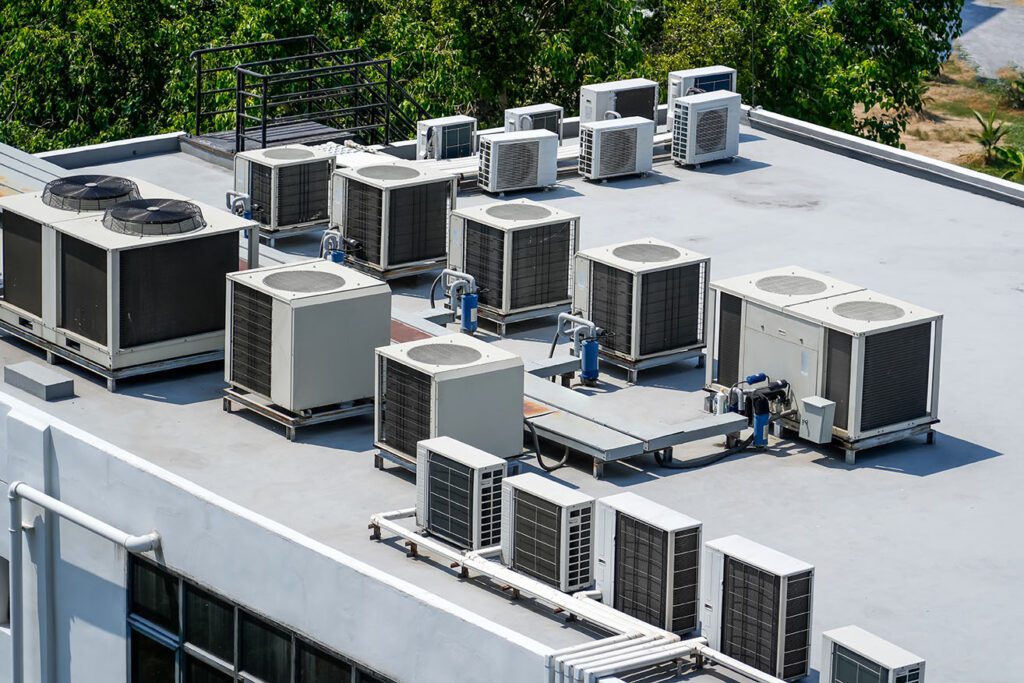When you are responsible for the comfort and safety of building occupants, a little knowledge about packaged rooftop units and other commercial HVAC systems can go a long way.
Understanding Packaged Rooftop Units
Packaged rooftop units are a popular choice for commercial HVAC systems due to their efficiency, versatility, and ease of installation. These self-contained units are designed to provide heating, ventilation, and air conditioning (HVAC) for buildings, making them a convenient and cost-effective solution.
Benefits of Packaged Rooftop Units
- Efficiency and Energy Savings: packaged rooftop units are often more energy-efficient than traditional split systems, leading to lower utility bills. Modern units incorporate advanced technologies like variable refrigerant flow (VRF) and inverter compressors, which optimize energy consumption based on demand.
- Versatility: these systems can be customized to meet the specific needs of different building types and sizes. They can be equipped with various features such as economizer cycles, humidity control, and air filtration to ensure optimal indoor air quality and comfort.
- Ease of Installation: this equipment is pre-assembled and factory-tested, reducing installation time and complexity. This can result in significant cost savings and minimal disruption to building operations.
- Reliability and Durability: packaged rooftop units are designed to last for many years with proper maintenance. High-quality components and robust construction ensure long-term performance and reliability.
Lifespan of Packaged Rooftop Units
The expected lifespan of a packaged system can vary depending on factors such as maintenance practices, operating conditions, and the quality of the unit. With proper care, they can typically last between 15 and 20 years.
Latest Technology and Energy-Saving Features
- Economizer Cycles: Economizer cycles take advantage of outdoor air to provide free cooling when conditions are favorable. This can significantly reduce energy consumption during mild weather.
- Advanced Filtration Systems: High-efficiency air filters can remove pollutants, allergens, and other contaminants from the indoor air, improving air quality and the health of building occupants.
Maintenance and Service
Regular maintenance is essential for ensuring the efficient and reliable operation of a PRU. Facility managers should schedule professional maintenance services at least twice a year, typically in the spring and fall. Routine maintenance tasks include:
- Cleaning and inspecting coils
- Checking refrigerant levels
- Lubricating moving parts
- Inspecting electrical components
- Testing safety devices
By investing in proper maintenance, facilities managers can extend the lifespan of their equipment, reduce energy costs, and maintain optimal indoor comfort.
Alternative Options for Commercial HVAC
While packaged rooftop units are a popular choice for commercial HVAC systems, they may not be the ideal solution for every building or application. Here are some alternative options to consider:
1. Split Systems
- Description: These systems consist of an outdoor condenser unit and an indoor evaporator unit connected by refrigerant lines.
- Advantages: Can be more flexible for retrofitting existing buildings, and individual units can be added or removed as needed.
- Disadvantages: More complex installation, can be less efficient, and may require more space.
2. Variable Refrigerant Flow (VRF) Systems
- Description: Similar to split systems, but use a more advanced control system to efficiently distribute refrigerant to multiple indoor units.
- Advantages: Highly efficient, can provide precise temperature control for individual zones, and can be used in larger buildings.
- Disadvantages: Can be more expensive to install and may require more complex maintenance.
3. Chilled Water Systems
- Description: These systems use a central chiller to produce chilled water, which is then circulated throughout the building to provide cooling.
- Advantages: Highly efficient for large buildings, can be used with a variety of indoor units, and can be more flexible for future expansions.
- Disadvantages: Higher initial cost, more complex installation and maintenance, and may require a dedicated cooling tower.
4. Hybrid Systems
- Description: These systems combine multiple HVAC technologies to optimize efficiency and performance.
- Advantages: Can provide flexibility and adaptability to changing building needs.
- Disadvantages: May require more complex design and maintenance.
The best choice for your commercial HVAC system will depend on factors such as building size, energy efficiency goals, and budget. Wicked Cool Mechanical can help you evaluate these options and select the most appropriate solution for your specific needs. Contact us for answers to your HVAC questions or to request service.

